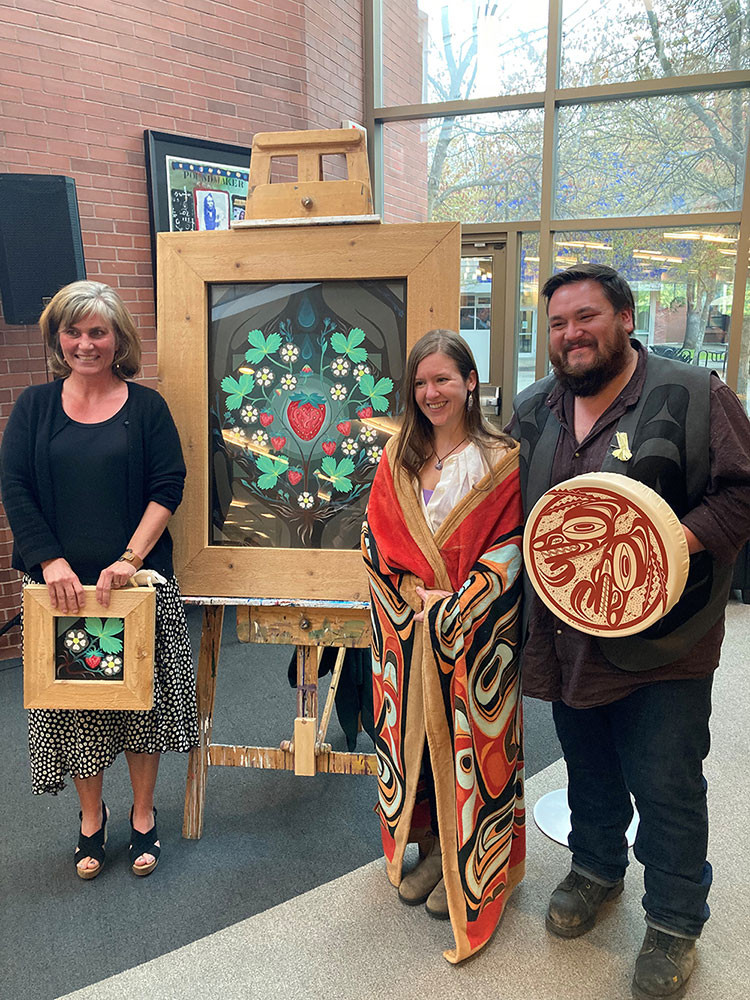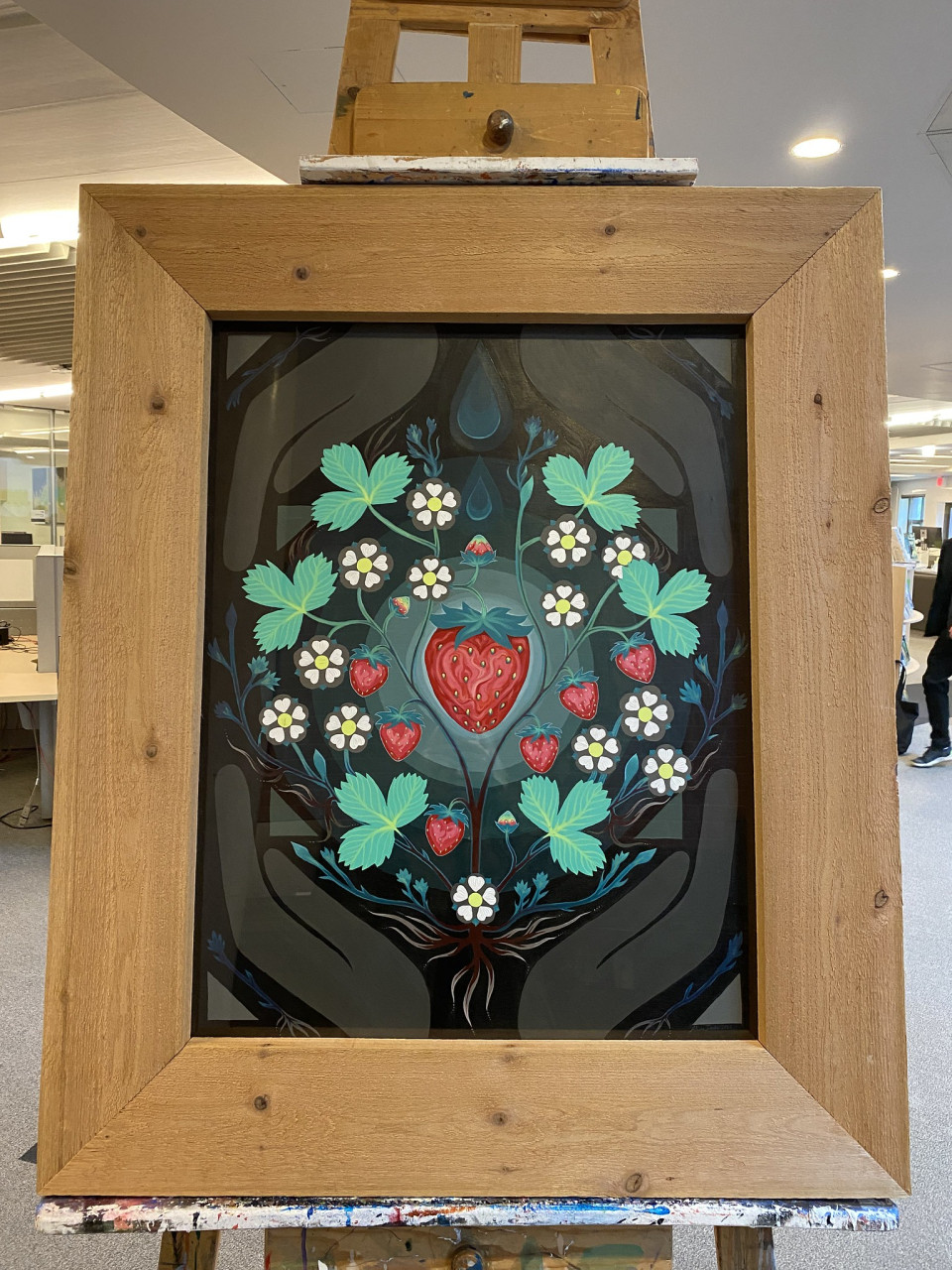Faculty and staff at Camosun College came together as a community to reground, reconnect and reflect at this year’s Wall Optional event.

Camosun College
Instructional designer Sue Doner, student Alisha Parks and instructor Hjalmer Wenstob stand next to the painting 'Gifts of the Heartberry'
The one-day conference took place on April 27 and included the publication of faculty stories, a new teacher recognition initiative and the gifting of a painting by a student as part of their project on decolonizing how Camosun supports disability.
“Walls Optional is a celebration of what Camosun is all about – we are all learners,” explains Sybil Harrison, Director of Learning Services at Camosun. “The ability for instructors and students to learn with each other and from each other was important throughout the pandemic, and equally so as we emerge from the pandemic.”
This year, the college launched a new teacher recognition initiative through the Teaching and Learning Council. A total of 27 teachers were nominated by students and colleagues and were recognized at the conference in four categories: innovation in education, collaborative education, student success, and educational leadership.
Showcase is an anthology of faculty stories that accompanies the Walls Optional conference and is published on the same day. The Camosun Showcase 2022: Professional, Scholarly and Creative Activity is available in Camosun College's institutional repository.
At the end of the event, student Alisha Parks who is of Mohawk, Irish and Danish ancestry, revealed the painting titled ‘Gifts of the Heartberry.’ This artwork, which is to be hung in the Lansdowne Library, has been gifted to the college as part of a special project for Indigenous Education program with instructor Hjalmer Wenstob. Alisha’s project, ‘Heartberry methodology: decolonizing how Camosun supports disability’, was done in collaboration with Sue Doner from the Centre for Excellence in Teaching and Learning and Alison Bowe from the Centre for Accessible Learning.
“As an Indigenous student with disability, I feel a personal accountability to find ways to generate positive transformations in terms of accessibility,” says Alisha.
Alisha adds, “I hope that the painting can serve as a beacon for how disability can be viewed differently. The heartberry plant can be understood as the collective community of Indigenous students with disability, allies, support and accessibility tools. The roots, leaves, flowers, stems, berries, seeds, shoots and runners, hands, arrows, circles and cedar frame of the painting each speak to important values and methodology of the heartberry.”
Backgrounder 1
Teacher recognition awards at Camosun
The Teaching Recognition initiative at Camosun College resulted in 27 nominations from students and faculty. Below are the 2022 nominations.
Innovation in Education recognizes faculty for thinking outside of the box in their teaching and assessment practices, integrating new and innovative ways to help students thrive.
- Susan Halsall, Marketing, School of Business;
- Stan Jung, Finance, School of Business;
- Lindsay Lichty, Early Learning and Care, School of Health and Human Services;
- Jana Suraci, Medical Radiography, School of Health and Human Services.
Collaborative Education recognizes faculty for building internal and external partnerships to promote engaging experiential student opportunities
- Keri Nori, Accounting, School of Business;
- Jacqueline Quinless, Social Work, School of Arts and Science;
- Nicole Kilburn, Anthropology, School of Arts and Science;
- Leanne Robb, Health Care Assistant, School of Health and Human Services;
- Michael Weaver, Culinary Arts, School of Trades and Technology.
Student Success recognizes faculty for attending to learner variability, championing diversity and inclusion, and designing flexible approaches that better meet the needs of all learners.
- Caitlan Gau, Continuing Care, School of Health and Human Services;
- Jody Isaac, Employment Training and Preparation, School of Access;
- Dean Janzen, Motor Vehicle and Metal Trades, School of Trades and Technology;
- Neil Meanwell, Chemistry, School of Arts and Science;
- Kate Pettem, Biology, School of Arts and Science;
- Katie Tanigawa: English, School of Arts and Science;
- Sarah Cockburn, Biology, School of Arts and Science;
- Sarah Erdelyi, Medical Radiography, School of Health and Human Services;
- Selena Hebig, Nursing, School of Health and Human Services;
- Marina Jaffey, Marketing, School of Business;
- Carrie Kobelsky, Psychology, School of Arts and Science;
- Heather Frame, Health Care Assistant – ESL, School of Health and Human Services;
- Julia Liska, Health Care Assistant – ESL, School of Health and Human Services;
- Lisa Robertson, Health Care Assistant – ESL, School of Health and Human Services;
- Diane Nadeau, Nursing, School of Health and Human Services;
- Maureen Niwa, English, School of Arts and Science;
- Tara Tudor, Anthropology, School of Arts and Science.
Education Leadership recognizes faculty who mentor other faculty, lead faculty teams and champion quality education above and beyond the classroom.
- Carl Everitt, Chair of Hospitality, Tourism and Golf Management, School of Business.
Backgrounder 2
Gifts of the Heartberry
As part of the Indigenous Education program, student Alisha Parks worked on a special project for Indigenous Education program with instructor Hjalmer Wenstob. Alisha’s project ‘Heartberry methodology: decolonizing how Camosun supports disability’ was done in collaboration with the Centre for Excellence in Teaching and Learning and the Centre for Accessible Learning. Here is a condensed version of the methodology:
We can understand the heartberry plant as the collective community of students with disability, allies, support and accessibility tools. The heartberry plant’s roots represent accessibility that acknowledges and supports the intersectionality that sustains us. The leaves are transformations that happen through collaborations, capacity building and creating positive spaces for disability and accessibility. The flowers are fertile locations for understanding disability through a social model that allows for generative possibility in accessibility centres and tools. The stems are the supportive structures that can provide a framework for connecting experience and disabled ontologies with accessibility tools, support centers and education paradigms. The berries are the gifts that each student with disabilities can share. Each is unique and in differing stages of its own agentic expansion. The seeds are the possibilities and potentialities generated by students, academics, faculty and staff. The shoots and runners of the plant move outward and sideways taking root in various places to increase the capacity of the plant. These are the endless possibilities of research, space creation, and facilitation. The hands are our ancestors, the land and the ecologies that hold and gifts us knowledge, care and love.
Contact information
Rodney Porter
Communications and MarketingCamosun College
Additional Contact Info
Sybil Harrison, Director of Learning Services
250-415-1900

